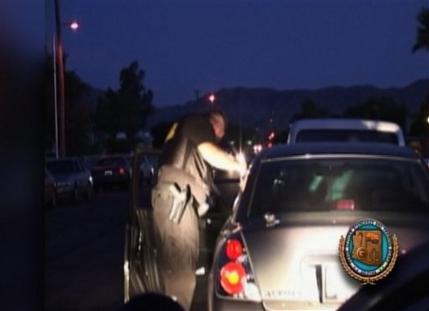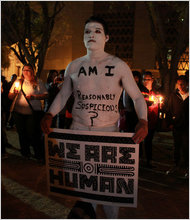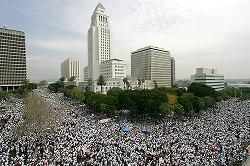
Umar Farouk Abdulmutallab
WASHINGTON Homeland Security Secretary Janet Napolitano conceded Monday that the aviation security system failed when a young man on a watchlist with a U.S. visa in his pocket and a powerful explosive hidden on his body was allowed to board a fight from Amsterdam to Detroit.The Obama administration has ordered investigations into the two areas of aviation security – how travelers are placed on watch lists and how passengers are screened – as critics questioned how the 23-year-old Nigerian man charged in the airliner attack was allowed to board the Dec. 25 flight.A day after saying the system worked, Napolitano backtracked, saying her words had been taken out of context.”Our system did not work in this instance,” she said on NBC’s “Today” show. “No one is happy or satisfied with that. An extensive review is under way.”The White House press office, traveling with President Barack Obama in Hawaii, said early Monday that the president would make a statement from the Kaneoho Marine Base in the morning. White House spokesman Bill Burton did not elaborate.Billions of dollars have been spent on aviation security since the Sept. 11, 2001, terrorist attacks, when commercial airliners were hijacked and used as weapons. Much of that money has gone toward training and equipment that some security experts say could have detected the explosive device that Umar Farouk Abdulmutallab is accused of hiding on his body on a flight from Amsterdam to Detroit.On Sunday, Napolitano said, “One thing I’d like to point out is that the system worked.” On Monday, she said she was referring to the system of notifying other flights as well as law enforcement on the ground about the incident soon after it happened.
The top Republican on the House Homeland Security Committee took issue with Napolitano’s initial assessment.Airport security “failed in every respect,” Rep. Peter King of New York said Sunday on CBS’ “Face the Nation.” “It’s not reassuring when the secretary of Homeland Security says the system worked.”Investigators are piecing together Abdulmutallab’s brazen attempt to bring down Northwest Airlines Flight 253 on Dec. 25. Law enforcement officials say he tucked below his waist a small bag holding his potentially deadly concoction of liquid and powder explosive material.
Harold Demuren, the head of the Nigerian Civil Aviation Authority, says Abdulmutallab’s ticket came from a KLM office in Accra, Ghana. Demuren said Monday that Abdulmutallab bought the $2,831 round-trip ticket from Lagos, Nigeria, to Detroit via Amsterdam on Dec. 16.
Demuren declined to comment about Abdulmutallab’s travels in the days before he boarded his Dec. 24 flight from Lagos to Detroit via Amsterdam, saying FBI agents and Nigerian officials view the information as “sensitive.” He says Abdulmutallab checked into his flight with only a small carryon bag.Abdulmutallab had been placed in a U.S. database of people suspected of terrorist ties in November, but there was not enough information about his activity that would place him on a watch list that could have kept him from flying.
However, British officials placed Abdulmutallab’s name on a U.K. watch list after he was refused a student visa in May.Home Secretary Alan Johnson added that police and security services are looking at whether Abdulmutallab was radicalized in Britain.
Abdulmutallab received a degree in engineering and business finance from University College London last year and later applied to re-enter Britain to study at another institution. Johnson said Monday he was refused entry because officials suspected the school was not genuine and they then put his name on the list.
Johnson says that people on the list can transit through the U.K. but cannot enter the country.Officials said he came to the attention of U.S. intelligence last month when his father, Alhaji Umar Mutallab, a prominent Nigerian banker, reported to the American Embassy in Nigeria about his son’s increasingly extremist religious views. In a statement released Monday morning, Abdulmutallab’s family in Nigeria said that after his “disappearance and stoppage of communications while schooling abroad,” his father reached out to Nigerian security agencies two months ago. The statement says the father then approached foreign security agencies for “their assistance to find and return him home.”
The family says: “It was while we were waiting for the outcome of their investigation that we arose to the shocking news of that day.”
The statement did not offer any specifics on where Abdulmutallab had been.
Abdulmutallab’s success in smuggling and partially igniting the material on Friday’s flight prompted the Obama administration to promise a sweeping review of aviation security, even as the Homeland Security secretary defended the current system.
White House spokesman Robert Gibbs said the government will investigate its systems for placing suspicious travelers on watch lists and for detecting explosives before passengers board flights.
Both lines of defense were breached in an improbable series of events Christmas Day that spanned three continents and culminated in a struggle and fire aboard a Northwest jet shortly before its safe landing in Detroit. Law enforcement officials believed the suspect tried to ignite a two-part concoction of the high explosive PETN and possibly a glycol-based liquid explosive, setting off popping, smoke and some fire but no deadly detonation.
An apparent malfunction in a device designed to detonate the PETN may have been all that saved the 278 passengers and the crew aboard Northwest Flight 253. No undercover air marshal was on board and passengers and crew subdued the suspect when he tried to set off the explosion. He succeeded only in starting a fire on himself.
Security experts said airport “puffer” machines that blow air on a passenger to collect and analyze residues would probably have detected the powder, as would bomb-sniffing dogs or a hands-on search using a swab. Most passengers in airports only go through magnetometers, which detect metal rather than explosives.
Abdulmutallab was treated for burns and was released Sunday to a prison 50 miles outside of Detroit.
Stiffer boarding measures have met passengers at gates since Friday and authorities warned travelers to expect extra delays returning home from holidays.
Adding to the airborne jitters, authorities detained a man, also from Nigeria, who locked himself in the bathroom on Sunday’s Northwest flight 253 from Amsterdam as it was about to land in Detroit. Investigators concluded he posed no threat. Despite the government’s decision after the attempted Friday attack to mobilize more air marshals, none was on the Sunday flight from Amsterdam.





